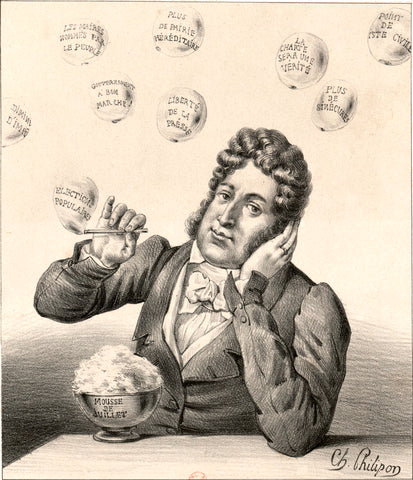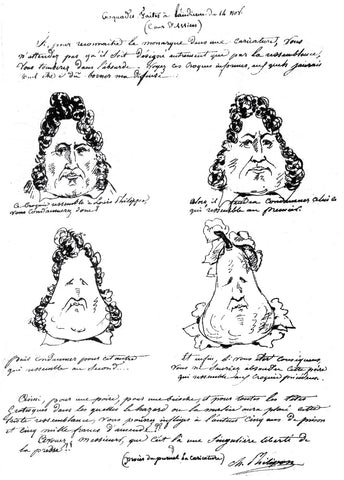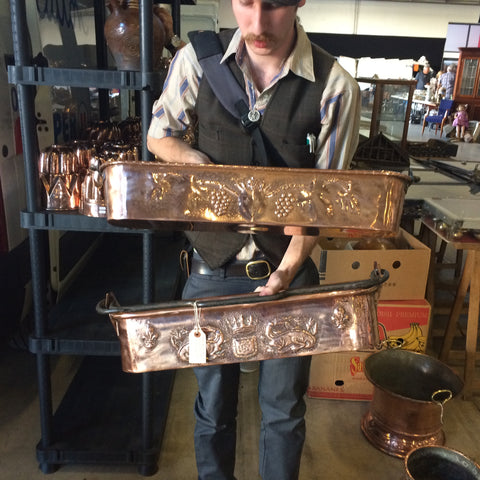- Continue Shopping
- Your cart is empty
Spring 2019 Arrivals from France Coming Soon!
It's spring and that means our latest arrivals from our winter buying trip to France are on their way! As always, we will be closing for a week while we unpack so stay tuned for an update on the arrival of our Spring 2019 Collection from France! We will be closed Wednesday, April 17th and will re-open our doors on Wednesday, April 24th at 10:00 am. Until then, here's a few of our finds you will be seeing soon in our shop or online.

Louis Philippe: This is not a Pear!
The story is one that goes down as maybe one of the greatest in French art history. Who knew that the drawing of a pear could land you in prison for fifteen months with an additional 10,000 franc fine on top of that! The date was November 14th, 1831. Charles Philipon, a lithographer, caricaturist, and journalist, then 29 years of age, ran a year-old weekly by the name of La Caricature.

Charles Philipon
The journal was notorious for its provocations, and by that November date, Philipon had been subject to eleven prosecutions. The royal government was cracking down on the press and Philipon had been taken to court in Paris for his “transgressions.” This time, his drawings were charged with "outrage against the person of the King." The reason for his trial was due to the fact that he had published a drawing in his weekly showing that the head of the king, Louis-Philippe, could be magically transformed into a pear in just four easy steps (the word for 'pear' – poire – was common slang for "dupe" in France at the time).

His choice of defense at his trial would be one that would become legend. Taking the stand, Philipon argued that maybe his cartoon DID look like the King. But what was the "resemblance"? Something that could never be the property of a "single man" he argued. Philipon then presented the court with a quick sketch he did of the same four drawings, the sequence again showing Louis-Philippe’s head morphing into a pear. There was no doubt that the sketches were held together by imperceptible links. The first did indeed look like Louis Philippe and the last resembled the first in a way, however, it was clearly a pear.

Philipon's Defence Sketches
Philipon then began to attack the terms of trial stating that if “resemblance” could be owned, then the system would lead the law into absurdity. Where would it end? He then declared that a king may only be recognized by his symbols, and since his portrait had no crown, or written title or name, then how would it be possible to say that this was a depiction of the “real” king? The royally backed court took little sympathy, and his newspaper was seized by the state. In prison, however, Philipon would notice that the walls of his cell were covered in pear graffiti. Similar caricatures would spring up all over Paris and France for the next decade. The unintended consequence of the affair would only popularize the image, especially among the illiterate. The artists that followed in Philipon’s footsteps (Daumier for example) would turn the pear into a hated image subject to the mercy of public rage and would further inflict a variety of symbolic tortures on the Louis-Philippe, depicting the pear hanged, drawn, and quartered, and much more.

When Philipon was later accused of inciting regicide due to a drawing of the pear on a pedestal on the site where Louis XVI was guillotined, he simply retorted that if anything, he could only be accused of inciting the public to “make some jam”!
Napoleon Bonaparte and His Famous Hands
Ask anyone to do an impression of the French Emperor Napoleon Bonaparte and almost everyone will strike a pose with one leg slightly forward and right hand thrust in coat. Even two hundred years after his death, we all still know how to do it, but why is it so closely associated with him?

It is often stated that this was just an eighteenth and nineteenth century artist’s convention for portraiture, and that it was meant to convey good breeding and calm reserve while in command. However, this pose in portraits became such a cliché with many claiming that artists simply did not know how to paint hands that it fell out of fashion by the end of the eighteenth century to a large degree. One conjecture is that the Scottish artist who did Napoleon’s portraits was attempting to drum up more positive P.R. to overseas English speaking audiences, since the fad was so popular in England and the colonies.


What most people don’t know though is that Napoleon Bonaparte was unusually vain about his hands. Apparently he had very beautiful hands and was very subconscious about them. According to Betsy Balcombe, the young woman who kept him company during his exile on St. Helena, “his hand was the fattest and prettiest in the world; his knuckles dimpled like those of a baby, his fingers taper and beautifully formed, and his nails perfect.” Thus, out of habit, Napoleon would try and hide his hands.

When he wasn’t stuffing them in his pockets, one could count on him distracting you by pulling your ears. A sign of affection for his intimates, to have your ear pulled by the dainty hands of Napoleon was looked up on as a coveted gesture. It even became a badge of honor for his Imperial Guard.


Louis XVI: Humble Getaway or Scandalous Extravagance
When considering the reign of Louis XVI, it becomes difficult not to mention Marie Antoinette, one of the most renowned women of her day. Brought to France from Austria to be crowned Queen of France at the age of 14, she was immediately thrust into the pomp and ceremony of the French court. With courtiers watching her every move from sunrise to sundown, there was little chance to escape.

Marie Antoinette
Louis XVI, taking pity on his new bride offered her the Petit Trianon as a gift and gave her full ownership over the property. Marie Antoinette soon found herself frequently at her new little getaway and spared no cost in making it her own.

Le Petit Trianon
In response to the rigid and symmetrical design of the gardens of Versailles, she immediately began work on the gardens and had them redesigned in the “English” fashion. Architect, Richard Mique, carried out a complete overhaul with meandering paths, hills, streams, and a small neo-classical Temple of Love. Marie Antoinette even commissioned him to build a complete mock farming village called the Petit Hameau (little hamlet).

Le Hameau
A contrast to the opulence of the Chateau de Versailles, this “rustic” area was to be her personal retreat. Invitations were exclusive; not even Louis XVI frequented her new paradise. Privacy was paramount in this little haven since eating, sleeping, and all other seemingly trivial things were a public affair. However, on occasion she would invite all of her close friends over. In order to further her idea of the “simpler life”, she would even put on performances as a milkmaid in the small theatre of the Trianon, but invitations were selective.

Theatre in Le Petit Trianon
Those outside of the Queen’s circle who were spiteful would give the Petit Trianon nicknames like “Little Vienna”. A place of escape from the formalities of court life and a place to shake off the burden of her royal responsibilities, the Petit Trianon was a place of intimacy (and pleasure). Even the windows had mirrored blinds! Is it any wonder that her reign was full of rumors and accusations of scandal?
Louis XV: The Height of Glamour
Louis XV was infamous for the many mistresses he had during his reign, the most celebrated being Madame de Pompadour and Madame du Berry. But what is a woman to do to catch the eye of the French king in the eighteenth century. Well, fashion, of course!
The more one could stand out the better, and what better way than one's hairstyle. Women (and men) of the period were well known for wearing powdered wigs with lots of curls and twists. Though we shy away from gray hair in this era and do everything in our power to hide our roots, in the eighteenth century, it was a distinguishing mark to sport gray or silver hair.

Louis XV and Madame de Pompadour
Not only this, but the taller one could make it the more eye-catching one would be. Madame de Pompadour, for example, would wear her hair so high that it was almost gravity defying. She must have been very cautious when passing underneath a chandelier for fear of knocking it over. And ribbons in your hair may be one thing, but try filling your wig with miniature nests, flowers, and small faux birds, or even a model sized galleon!

Hairstyles of the 18th Century
On top of that, to attain further height, one could attach tall plumes or wear a small tricorne hat. Hours would go by simply trying to achieve these standards. Whereas beauty may be held in high regard today, at least we no longer have to break our necks trying to take in these extravagant styles. The pompadour hair style (named for Madame de Pompadour) of today is noticeably tamer.

Louis XIV: A visit that killed the chef
Scenario:
You are an event planner for a high ranking noble and are told that the King of France and his 600 plus courtiers are coming for a visit. You are now responsible for all the entertainment and food for these guests and you only have 15 days to prepare.
Such was the case in 1671 when Louis XIV decided to visit the Prince de Conde at the Chateau of Chantilly. Preparations began immediately as large orders of food, wine, and other necessities were made. In charge of this all was Francois Vatel, a man whose name is well recognized to this day by all modern day cooks and chefs.
Fifteen days might seem like enough time to prepare for a family reunion these days, but in the time of the great “Sun King” who demanded the very best of everything, the task was very daunting. Not only was the king demanding that all his courtiers be housed and fed, but they also needed to be entertained. The visit was to last three days. The first day presented one of many calamities for Vatel. Aside from other mishaps during the day, he had organized a grand fireworks display to distract the king and nobles, but unfortunately a fog rolled in and made it impossible to see. An embarrassment for Vatel, the following day he began showing signs of visible anguish.
And thus his fate was sealed on the second day. Vatel began it by doing inventory. When he got to the fish order, he asked the cart man with the fish in exasperation whether this was all of the fish. The cart man who assumed that Vatel was referring to only the fish in his cart and not the others that were on the road behind him replied that “this is all”. Vatel was crest-fallen. Nothing seemed to be going as planned for the man who was held in such high esteem. Unable to take the stress any longer, Vatel retired to his room and stabbed himself with his sword.
So if ever you are feeling a little stressed about a dinner party or event that you are organizing, just remember the scenario of Francois Vatel. At least you don’t have to cook for the King of France and his entire court!
Bring on the Kings...and our fall shipment from France!
If you love antiques, you love history. The old soul inside you calls out to connect with the past. At French Metro, we live and breathe history, and specifically French history. The story behind the French decorative arts is the story of the monarchy. Each king throughout history brought his signature style to the furnishings and accessories produced for his chateaux and his court. The artisans in the countryside then followed suit, adapting the designs of the day to their own regional idiosyncracies. French Metro wants to take you on a journey through the history of the French monarchy. Follow us over the coming weeks as the story of the kings unfolds through our four hundred new arrivals from France. Our doors will be closed on Tuesday, August 28th while we unpack, and we will reopen on Tuesday, September 4th. Bring on the kings and our fall shipment from France!
Summer Journey to Fall Arrivals
Summer is winding down, and French Metro is gearing up...for our latest arrivals from France. Harrison and Renee spent three weeks in June in France hunting for treasures to bring back to our shop in Fayetteville. From the southern regions of Provence and Languedoc to the northern provinces of Normandy and Brittany, we flew, we drove, we walked, and ended our travels with three days in Paris. Arriving soon are four hundred more antique arrivals so stay tuned!
Time to fly!
It’s June, and June at French Metro means it’s time to go back to France! Harrison and Renee will be hunting for treasures for the next three weeks, and Terry will be manning the shop in Fayetteville. So follow us along on Facebook as we post about our journey. Or stop in to see what Terry’s up to on Dickson Street.

Our spring shipment from France is ready for viewing!
Our latest arrivals from France are all about spring! We love to garden, and this shipment shows it--stone columns from a French manor house garden, a nineteenth century stone garden fountain, aged stone planters and urns, garden benches, and a magnificent statue of Saint Michael the Archangel fighting the dragon and giving his blessing.
Our doors have re-opened with our latest treasures. We will have our first sampling online soon, but in the meantime, come see what's new (or rather, old) at French Metro and pause in our tulip garden blazing in glory with 2000 tulips in bloom!












































